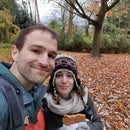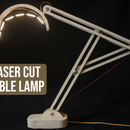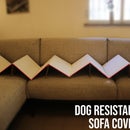Introduction: Plywood & Concrete Desk Organizers
In this instructable I'll show you how to make a set of desk organizers - a memo/notepad dispenser and a pen holder. The organizers are made of plywood and concrete, and I think they turned out pretty nice :) I gave them to my family and they loved it! The design took me a while, but making the actual objects is really easy - probably 10 minutes of work (plus some time for the concrete to dry). So if you're looking for an afternoon project or a quick gift idea, I think this project is perfect for you :)
I made a 1-minute video showing a quick overview of the entire project and I really recommend seeing it before diving into the details!
I cut the plywood on my laser engraver/cutter. I know laser-cut projects deter some people, some people don't appreciate projects made with 'fancy tools'. Stick with me! :) First, you can - if you really want - do this project without a laser cutter. More importantly, though, there are cheap laser engravers these days capable of engraving lots of stuff, but also cut through thin materials (I can cut up to 8-10mm of plywood on mine). Laser engravers are much easier to operate compared to almost anything else, so, even if you're not a technical person, I think that you should look at projects like this as inspirational - maybe you'll want a laser cutter too.
By the way, this is my first project using a laser cutter, so any tips and comments will be appreciated!
I hope you enjoy following along, and if you have any questions or comments - let me know!
Supplies
Supplies
- 3mm (0.12") Plywood or Birch.
- Wood glue (I used Elmer's).
- Concrete mix or plaster.
- Finishing oil (optional - I used teak oil)
Tools
- Laser engraver/cutter (I used an xTool D1, but there are cheaper ones - let me know if you need suggestions). If you don't have a laser cutter - you can still follow along if you have a scroll-saw (here's a video for a DIY scroll-saw).
- Hot glue gun (and hot glue..).
- Small paint brush (for the finishing oil).
Step 1: Model Your Creation
I designed the model in Fusion 360. For those who want to skip ahead, go for it - the DXF files are included in the next step. However, if you want to create your own models inspired by mine, here are a couple of tips for designing laser-cut stuff:
- Consider the 'kerf' of your laser cutter / saw. The 'kerf' is basically the size of the cut. When we draw plans, we draw 'lines'. But in real life, cuts are not infinitely thin - they have a width. If we ignore this, different parts of the model will not fit - they will be too loose. To take this into about, you need to make sure that the connections between different parts are 'too tight'. For example, my models are made of frames (top / bottom) and walls connecting them (see first GIF). I made each wall wider than the cuts made for them in the frames. The size of my laser-beam is about 0.1mm X 0.1mm (25.4mm = 1inch), which is pretty standard, and so that's the kerf I considered.
- Eventually, laser cuts are 2-dimensional, so it's tempting to work in 2D. However, I really suggest that you use a 3D modeling software - it takes extra time to create 3D models than it takes to imagine parts or draw them on paper / 2D software, but you'll never disregard something - everything will fit and you can see the proportions of things before making the object. This will often save time and will definitely save wasted materials. I use Fusion 360 and OnShape, both have a free version (which I use).
- Reach out! If you're frustrated with the design process, ask for help! There are many ways to do that including asking here in the comments, facebook groups, YouTube tutorials, and others.
Desk Organizers
Step 2: Laser Cut
Cut out the wood according to the attached DXF files.
For the pen holder you'll need to cut:
- Two copies of the base (frame) part.
- Ten copies of the wall.
For the notepad dispenser you'll need to cut:
- One copy of the bottom frame.
- One copy of the top frame.
- Fourteen copies of the wall.
I cut mine on the xTool D1 (10W module) at 100% laser power and 6mm/sec.
Step 3: Glue the Plywood Pieces
It's time to glue the wooden pieces together. I'll describe the process of making the pen holder, but making the notepad dispenser is identical (expect that it is a square!).
- Apply wood glue to the slots in the base (image #1).
- Lay it on a flat surface and squeeze in the walls. Make sure they fit in nicely and that they're flush (they touch the flat surface from below).
- Apply some glue to the other copy of the base.
- Slide it between the existing pieces (image #4). Make sure it's offset by about 1cm (1/3") from the top (see images #5-6). Later we'll be filling this offset with concrete (see step 6).
- Squeeze the walls tightly onto the frame.
- Make sure everything is aligned nicely.
- Remove any excess glue with a paper towel (I also used a flat screw driver in some places).
Let the glue dry before moving on to the next step. Most wood glues dry pretty fast :)
Step 4: Prepare for Casting Concrete
In step 6 we're going to cast the concrete bottom. We're going to fill the bottom part with concrete all the way up to the offset left in the previous step.
- Use some scotch-tape and seal the bottom part of the wooden parts so that concrete can't leak between the walls.
- Place the wooden parts on a flat piece of plexiglass/acrylic/glass so that the bottom of the wooden parts face it. Use some hot glue to hold it in place and to seal it.
- If you followed along, the wooden part should be glued in place and its bottom should form sort of a mold for the concrete (see image #4).
Step 5: Cast Concrete
- Mix concrete (with very fine gravel / no gravel!). Make sure it's a bit thinner than normal so that it could fill the gaps between the walls of the wooden part nicely.
- Pour concrete until its flush with the bottom frame (see the images).
- Use a plastic fork or something similar to make sure the concrete reaches the tougher areas.
- Shake the plexiglass a bit to make the concrete flat.
Let the concrete dry for about 24 hours before moving on!
Step 6: Finishing Touches
- Remove the desk organizers from the plexiglass.
- Cut away the hot glue and the scotch tape.
- Use a utility knife to remove any misbehaving pieces of concrete :)
At this point you're pretty much all done! You can smooth everything with a gentle sanding paper and apply some finishing oil to the wooden parts, but this is optional.
Step 7: You're All Done!
You're all done! I made a few of these as gifts and added some personalized engravings on the concrete as well. I placed these gifts inside the comic-book gift bags I made, and my family loved it :) I think they appreciated the fact that I made the gift just for them much more than they would appreciate store-bought gifts.
Thanks it for now. I hope you make your own desk organizers and enjoy them!





